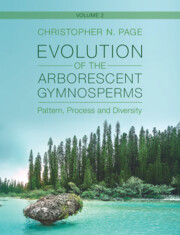Book contents
- Evolution of the Arborescent Gymnosperms: Pattern, Process and Diversity
- Reviews
- Evolution of the Arborescent Gymnosperms
- Copyright page
- Contents
- Preface and Acknowledgements
- Structure of the Volumes
- Part I Aims, Approaches and Diversity
- Part II Phylogenetic Bases and Revised Taxonomic Structure
- Part III Living Arborescent Gymnosperm Genetic Presentations
- Chapter 41 Fitzroya
- Chapter 42 Cryptomeria
- Chapter 43 Glyptostrobus
- Chapter 44 Taxodium
- Chapter 45 Sequoia
- Chapter 46 Sequoiadendron
- Chapter 47 Metasequoia
- Chapter 48 Cunninghamia
- Chapter 49 Taiwania
- Chapter 50 Athrotaxis
- Chapter 51 Araucaria
- Chapter 52 Wollemia
- Chapter 53 Agathis
- Chapter 54 Podocarpus
- Chapter 55 Retrophyllum
- Chapter 56 Nageia
- Chapter 57 Afrocarpus
- Chapter 58 Dacrydium
- Chapter 59 Dacrycarpus
- Chapter 60 Falcatifolium
- Chapter 61 Acmopyle
- Chapter 62 Halocarpus
- Chapter 63 Lagarostrobos
- Chapter 64 Manoao
- Chapter 65 Parasitaxus
- Chapter 66 Prumnopitys
- Chapter 67 Sundacarpus
- Chapter 68 Pectinopitys
- Chapter 69 Microcachrys
- Chapter 70 Pherosphaera
- Chapter 71 Phyllocladus
- Chapter 72 Saxegothaea
- Chapter 73 Lepidothamnus
- Part IV From Ecosystem Services to Conservation and Sustainability
- Selected Bibliography
- Genus Index
- Plate Section (PDF Only)
- References
Chapter 51 - Araucaria
Araucariales: Araucariaceae
from Part III - Living Arborescent Gymnosperm Genetic Presentations
Published online by Cambridge University Press: 11 November 2024
- Evolution of the Arborescent Gymnosperms: Pattern, Process and Diversity
- Reviews
- Evolution of the Arborescent Gymnosperms
- Copyright page
- Contents
- Preface and Acknowledgements
- Structure of the Volumes
- Part I Aims, Approaches and Diversity
- Part II Phylogenetic Bases and Revised Taxonomic Structure
- Part III Living Arborescent Gymnosperm Genetic Presentations
- Chapter 41 Fitzroya
- Chapter 42 Cryptomeria
- Chapter 43 Glyptostrobus
- Chapter 44 Taxodium
- Chapter 45 Sequoia
- Chapter 46 Sequoiadendron
- Chapter 47 Metasequoia
- Chapter 48 Cunninghamia
- Chapter 49 Taiwania
- Chapter 50 Athrotaxis
- Chapter 51 Araucaria
- Chapter 52 Wollemia
- Chapter 53 Agathis
- Chapter 54 Podocarpus
- Chapter 55 Retrophyllum
- Chapter 56 Nageia
- Chapter 57 Afrocarpus
- Chapter 58 Dacrydium
- Chapter 59 Dacrycarpus
- Chapter 60 Falcatifolium
- Chapter 61 Acmopyle
- Chapter 62 Halocarpus
- Chapter 63 Lagarostrobos
- Chapter 64 Manoao
- Chapter 65 Parasitaxus
- Chapter 66 Prumnopitys
- Chapter 67 Sundacarpus
- Chapter 68 Pectinopitys
- Chapter 69 Microcachrys
- Chapter 70 Pherosphaera
- Chapter 71 Phyllocladus
- Chapter 72 Saxegothaea
- Chapter 73 Lepidothamnus
- Part IV From Ecosystem Services to Conservation and Sustainability
- Selected Bibliography
- Genus Index
- Plate Section (PDF Only)
- References
Summary
Tall, and always remarkably erect, eventually large, dioecious evergreen, long-lived, resiniferous trees. When young and often throughout life they have very strongly whorled and stout, more or less level to typically somewhat ascending branch systems, usually with upturning tips, with the lower branch whorls either retained or eventually shed to leave clean trunks which sometimes bear further foliar episodes of crown reiteration from middle to higher portions of the trunk. Tree crowns generally highly symmetric.
- Type
- Chapter
- Information
- Evolution of the Arborescent GymnospermsPattern, Process and Diversity, pp. 232 - 266Publisher: Cambridge University PressPrint publication year: 2024

